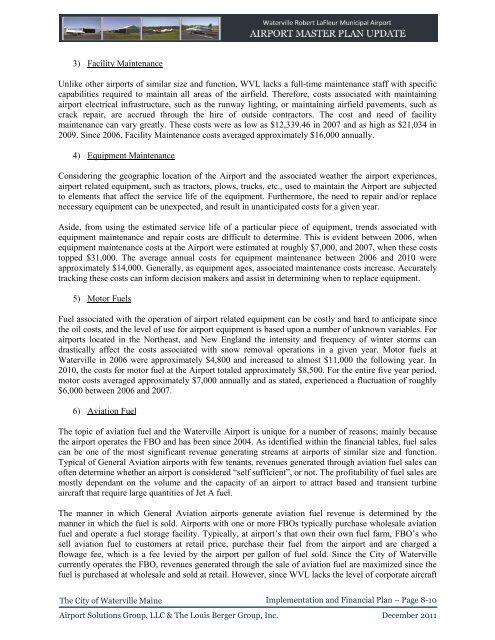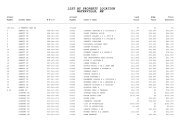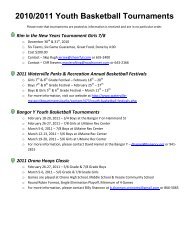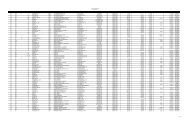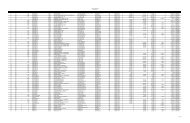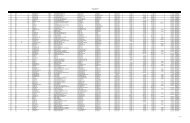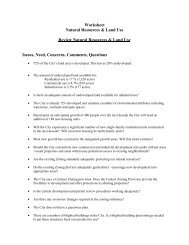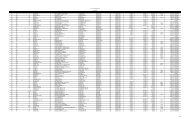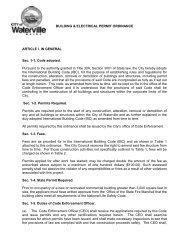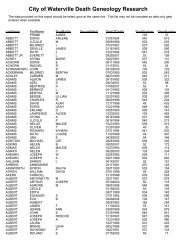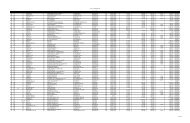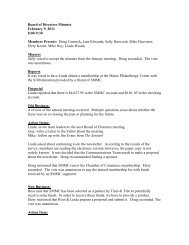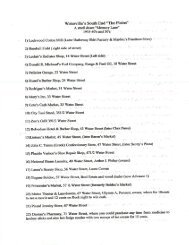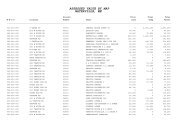Airport Master Plan 2012 - City of Waterville
Airport Master Plan 2012 - City of Waterville
Airport Master Plan 2012 - City of Waterville
Create successful ePaper yourself
Turn your PDF publications into a flip-book with our unique Google optimized e-Paper software.
3) Facility Maintenance<br />
Unlike other airports <strong>of</strong> similar size and function, WVL lacks a full-time maintenance staff with specific<br />
capabilities required to maintain all areas <strong>of</strong> the airfield. Therefore, costs associated with maintaining<br />
airport electrical infrastructure, such as the runway lighting, or maintaining airfield pavements, such as<br />
crack repair, are accrued through the hire <strong>of</strong> outside contractors. The cost and need <strong>of</strong> facility<br />
maintenance can vary greatly. These costs were as low as $12,339.46 in 2007 and as high as $21,034 in<br />
2009. Since 2006, Facility Maintenance costs averaged approximately $16,000 annually.<br />
4) Equipment Maintenance<br />
Considering the geographic location <strong>of</strong> the <strong>Airport</strong> and the associated weather the airport experiences,<br />
airport related equipment, such as tractors, plows, trucks, etc., used to maintain the <strong>Airport</strong> are subjected<br />
to elements that affect the service life <strong>of</strong> the equipment. Furthermore, the need to repair and/or replace<br />
necessary equipment can be unexpected, and result in unanticipated costs for a given year.<br />
Aside, from using the estimated service life <strong>of</strong> a particular piece <strong>of</strong> equipment, trends associated with<br />
equipment maintenance and repair costs are difficult to determine. This is evident between 2006, when<br />
equipment maintenance costs at the <strong>Airport</strong> were estimated at roughly $7,000, and 2007, when these costs<br />
topped $31,000. The average annual costs for equipment maintenance between 2006 and 2010 were<br />
approximately $14,000. Generally, as equipment ages, associated maintenance costs increase. Accurately<br />
tracking these costs can inform decision makers and assist in determining when to replace equipment.<br />
5) Motor Fuels<br />
Fuel associated with the operation <strong>of</strong> airport related equipment can be costly and hard to anticipate since<br />
the oil costs, and the level <strong>of</strong> use for airport equipment is based upon a number <strong>of</strong> unknown variables. For<br />
airports located in the Northeast, and New England the intensity and frequency <strong>of</strong> winter storms can<br />
drastically affect the costs associated with snow removal operations in a given year. Motor fuels at<br />
<strong>Waterville</strong> in 2006 were approximately $4,800 and increased to almost $11,000 the following year. In<br />
2010, the costs for motor fuel at the <strong>Airport</strong> totaled approximately $8,500. For the entire five year period,<br />
motor costs averaged approximately $7,000 annually and as stated, experienced a fluctuation <strong>of</strong> roughly<br />
$6,000 between 2006 and 2007.<br />
6) Aviation Fuel<br />
The topic <strong>of</strong> aviation fuel and the <strong>Waterville</strong> <strong>Airport</strong> is unique for a number <strong>of</strong> reasons; mainly because<br />
the airport operates the FBO and has been since 2004. As identified within the financial tables, fuel sales<br />
can be one <strong>of</strong> the most significant revenue generating streams at airports <strong>of</strong> similar size and function.<br />
Typical <strong>of</strong> General Aviation airports with few tenants, revenues generated through aviation fuel sales can<br />
<strong>of</strong>ten determine whether an airport is considered “self sufficient”, or not. The pr<strong>of</strong>itability <strong>of</strong> fuel sales are<br />
mostly dependant on the volume and the capacity <strong>of</strong> an airport to attract based and transient turbine<br />
aircraft that require large quantities <strong>of</strong> Jet A fuel.<br />
The manner in which General Aviation airports generate aviation fuel revenue is determined by the<br />
manner in which the fuel is sold. <strong>Airport</strong>s with one or more FBOs typically purchase wholesale aviation<br />
fuel and operate a fuel storage facility. Typically, at airport’s that own their own fuel farm, FBO’s who<br />
sell aviation fuel to customers at retail price, purchase their fuel from the airport and are charged a<br />
flowage fee, which is a fee levied by the airport per gallon <strong>of</strong> fuel sold. Since the <strong>City</strong> <strong>of</strong> <strong>Waterville</strong><br />
currently operates the FBO, revenues generated through the sale <strong>of</strong> aviation fuel are maximized since the<br />
fuel is purchased at wholesale and sold at retail. However, since WVL lacks the level <strong>of</strong> corporate aircraft<br />
The <strong>City</strong> <strong>of</strong> <strong>Waterville</strong> Maine<br />
Implementation and Financial <strong>Plan</strong> – Page 8-10<br />
<strong>Airport</strong> Solutions Group, LLC & The Louis Berger Group, Inc. December 2011


